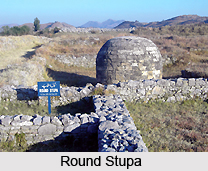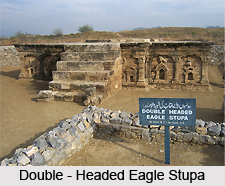 Sirkap is one of the archaeological sites of India which is nestled on the bank opposite to the city of Taxila, Punjab, and Pakistan. This ancient city was excavated by Hergrew from 1912-1930 under the supervision of Sir John Marshall. Some of its parts were further excavated by Mortimer Wheeler and his colleagues from 1944 and 1945.
Sirkap is one of the archaeological sites of India which is nestled on the bank opposite to the city of Taxila, Punjab, and Pakistan. This ancient city was excavated by Hergrew from 1912-1930 under the supervision of Sir John Marshall. Some of its parts were further excavated by Mortimer Wheeler and his colleagues from 1944 and 1945.
History of Sirkap
It was established by the Greco-Bactrian king Demetrius. He built this city after he invaded ancient India around 180 BC. It is also believed that Sirkap has been rebuilt by King Menander I.
According to historians, Sirkap was rebuilt many a times. Following its establishment by the Greeks, Sirkap was further rebuilt during the incursions of the Indo-Scythians. Later, it was again established by the Indo-Parthians after an earthquake in 30 AD.
It is also believed that Gondophares who was the first king of the Indo-Parthian Kingdom, constructed some parts of the city which mainly comprise of the double headed eagle stupa and the temple of the sun God.
Later, the city was overtaken by the Kushan kings. However, they abandoned it and established a new city at Sirsukh.
Architecture of Sirkap
The architecture of Sirkap features the characteristic of Greek cities. It has been observed by the historians that the ruins are Greek in character, similar to those of Olynthus in Macedonia. A number of Hellenistic artefacts have been discovered that reveal Greek mythological scenes.
Attractions of Sirkap
This historical site has various religious buildings to exhibit to its visitors and history lovers like Round Stupa, Apsidal Temple, and Double-Headed Eagle Stupa.
The Round Stupa is regarded as one of the oldest and important Stupas in the Indian-Subcontinent. There is an assumption surrounding this ancient Stupa. It is believed that in the 1st century AD, it was uprooted and thrown to its current place by a strong earthquake.
The building of Apsidal Temple is the largest sanctuary of Sirkap. It is designed with a square nave with several rooms and a circular room. The square nave is now used by the Buddhist monks.
The Double-Headed Eagle Stupa is noted for its design. The pilasters here are of a Greek design; in the middle arch, a Greek temple is shown and in the outer, a shrine of a Hindu design can be observed. It can also be observed that on top of these sanctuaries; a double-headed eagle is seated. The name of the Stupa is just derived from this eagle.



















